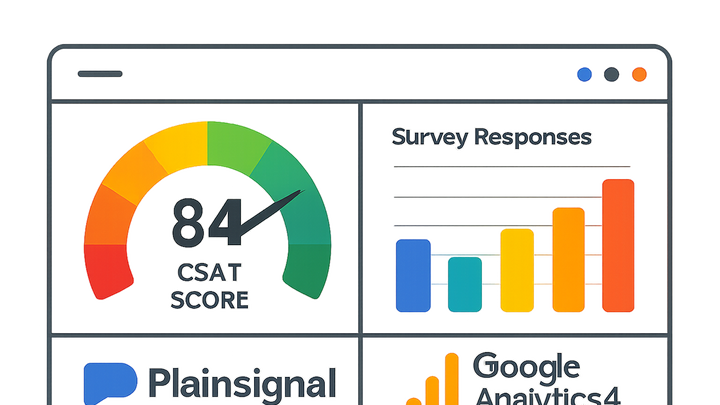Published on 2025-06-22T02:33:26Z
What is CSAT (Customer Satisfaction Score)? Examples and Implementation
CSAT, or Customer Satisfaction Score, is a key metric in analytics used to measure how satisfied customers are with a company’s product, service, or interaction. It is commonly collected through short surveys that ask users to rate their satisfaction on a numerical scale, such as 1 (very dissatisfied) to 5 (very satisfied). The CSAT score is calculated as the percentage of customers who provide a positive rating (typically 4 or 5) out of all survey responses. Monitoring CSAT helps businesses identify immediate customer sentiment, pinpoint pain points, and prioritize improvements in product design, customer support, and user experience. With modern analytics platforms like PlainSignal’s cookie-free analytics and Google Analytics 4, teams can seamlessly integrate CSAT tracking into digital touchpoints to obtain real-time insights and automated reporting. This continuous feedback loop empowers organizations to respond swiftly to customer needs and drive satisfaction improvements.
Csat (customer satisfaction score)
CSAT measures customer satisfaction as the percentage of positive survey responses, tracked via tools like PlainSignal and GA4 for real-time insights.
Understanding CSAT
CSAT, or Customer Satisfaction Score, is a metric that quantifies the percentage of customers who are satisfied with a product, service, or interaction. It is valued for its simplicity and direct insight into customer sentiment.
-
Definition and formula
CSAT measures the percentage of customers who express positive satisfaction ratings. It is calculated using a simple formula.
-
Survey question
Typically asks, “How satisfied are you with [product/service]?” on a scale (e.g., 1-5).
-
Calculation
CSAT (%) = (Number of positive responses / Total responses) × 100.
-
-
Use cases
CSAT can be measured after various customer interactions to gather immediate feedback.
-
Transactional csat
Captured right after a purchase, support ticket resolution, or other transactional touchpoint.
-
Relationship csat
Gathered periodically (e.g., quarterly) to assess overall satisfaction.
-
-
Benefits and limitations
CSAT is valued for its simplicity and clarity, but it has some constraints to be aware of.
-
Benefits
Easy to implement and understand, provides quick insights into customer sentiment.
-
Limitations
Subject to bias and may not fully capture long-term loyalty or emotional connection.
-
Tracking CSAT with SaaS Analytics Tools
Learn how to integrate CSAT tracking using both PlainSignal’s cookie-free analytics and Google Analytics 4.
-
PlainSignal (cookie-free analytics)
Embed the PlainSignal tracking snippet and fire a custom CSAT event when users submit feedback:
<link rel="preconnect" href="//eu.plainsignal.com/" crossorigin /> <script defer data-do="yourwebsitedomain.com" data-id="0GQV1xmtzQQ" data-api="//eu.plainsignal.com" src="//cdn.plainsignal.com/plainsignal-min.js"></script>Use PlainSignal’s
signal.event()method to send CSAT responses.-
Embedding the tracking snippet
Place the
<link>and<script>tags in your site’s<head>to load PlainSignal. -
Configuring csat events
Call
signal.event('csat_response', { score: userScore })when a customer submits their rating.
-
-
Google analytics 4 (GA4)
Set up custom events in GA4 to capture CSAT scores and analyze results in the GA4 UI or via Explorations.
-
Setting up custom parameters
Use
gtag('event', 'csat_survey', { 'csat_score': score });to send the rating. -
Analyzing csat in GA4
Create an Events report or Exploration to view average scores, distributions, and segments.
-
Best Practices for CSAT Surveys
Follow these guidelines to design effective CSAT surveys and derive actionable insights.
-
Survey design
Craft clear, concise questions and optimize timing to maximize response rates.
-
Question clarity
Use straightforward language and a consistent scale (e.g., 1=Very Unsatisfied to 5=Very Satisfied).
-
Keep it short
Limit surveys to one or two questions to reduce respondent fatigue.
-
-
Data analysis
Interpret CSAT data effectively by segmenting and tracking trends over time.
-
Segmentation
Break down scores by user segments, channels, or cohorts to identify patterns.
-
Trend tracking
Monitor CSAT over time to detect improvements or declines in customer satisfaction.
-
-
Actionable insights
Turn CSAT feedback into meaningful improvements for your product and service.
-
Close the feedback loop
Follow up with respondents to inform them about changes based on their input.
-
Prioritize issues
Focus on high-impact pain points that drive customer dissatisfaction.
-
